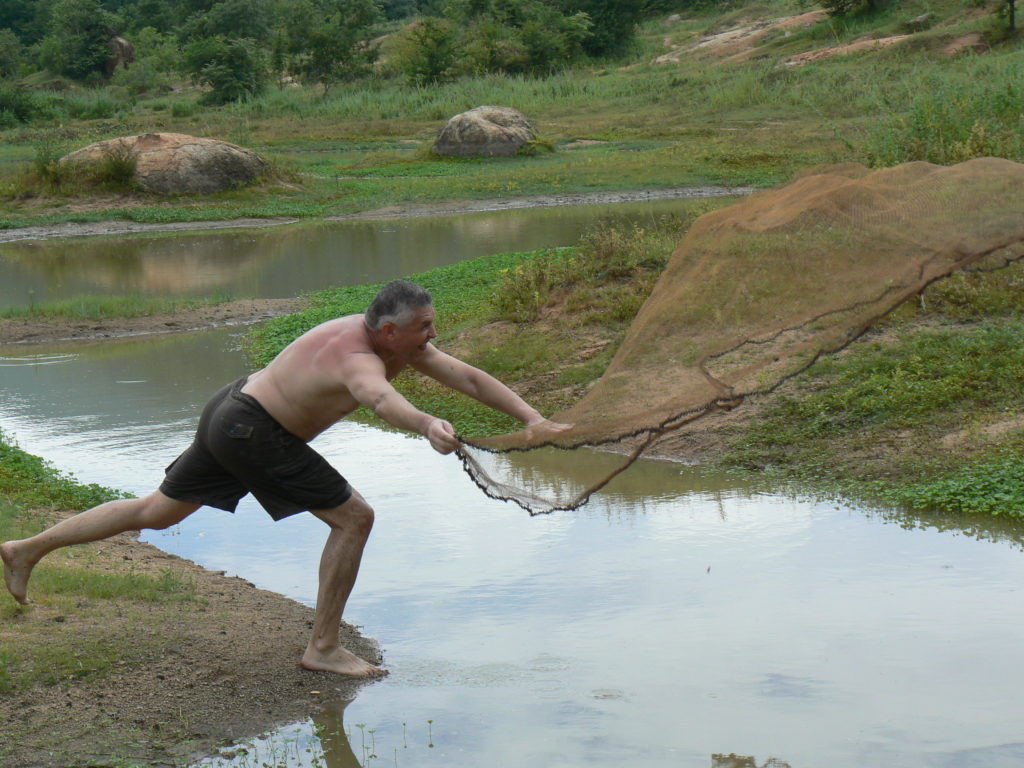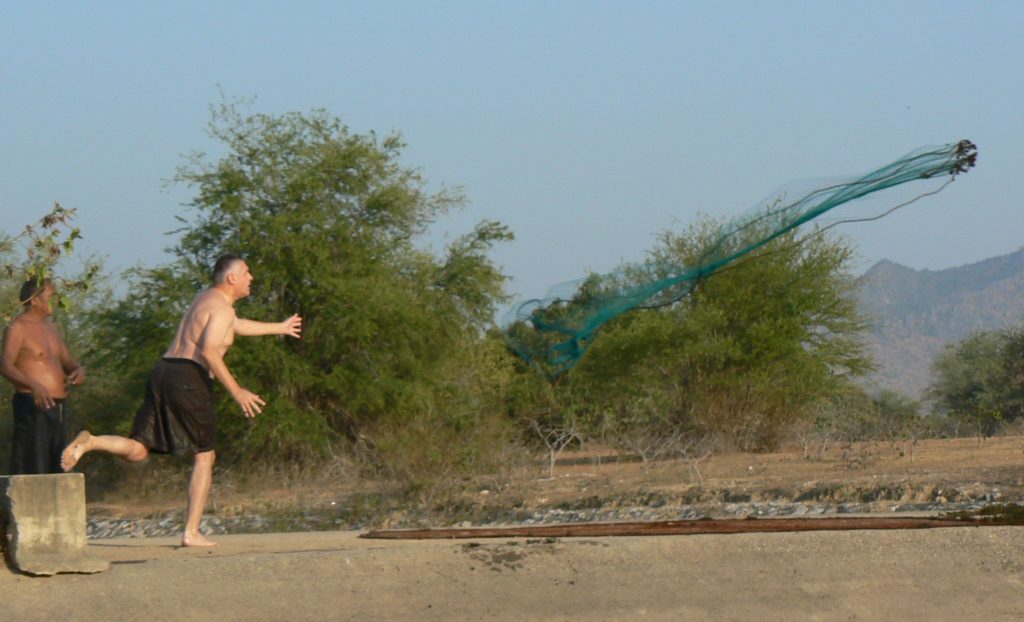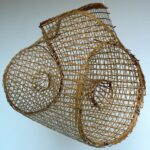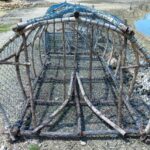Description of cast nets used in Thailand
Cast nets in Thailand are available in different radius models. I prefer one with a radius of 3.5 meters, which is from the center of the net to the outer axial rim chain, which acts as a sinker.

Before using the net, pockets on the outer rim must be created. The sinker chain is knotted about 0.5 meters into the net, creating pockets at the rim that are about 25 cm deep.
How to set up a large cast net for throwing
It isn’t easy to describe the complex technique of preparing such a large net for casting. But the consecutive steps are as follows:
- The left hand holds the net about 10 cm below the center between the thumb and index finger.
- The same hand stretches out to the left as much as possible, and the right hand simultaneously holds the net again between the thumb and index finger and stretches out as much as possible to the right side.
- The right hand transfers the tightly compressed net to the left hand in the middle of the body.
- Both the left thumb and index finger take the initially held net and the newly handed-over net and hold both net parts tightly together.

- The left hand with both net parts will be stretched out again as much as possible to the left and held high in the air. The remaining net with the sinker line is tangling freely in the air now.
- Slight shakes with the left and right hand straighten up the free-falling net parts so that there are no whirls in the net and the netting falls straight and parallel.
- With the left hand still held high, the fingers of the right hand will be placed onto the net directly in front of the body.

- I am holding the netting with my thumb and index finger on the right hand about 0.5 m above the sinker line. The other fingers are creeping along the net in a tingling motion, collecting about one-third of the net circumference.
- After finishing, this 1/3 of the netting will be placed over the left shoulder and held on the shoulder by the net itself. This is a bit of an unusual motion but essential for a perfect cast.
- Now, the remaining 2/3 of netting is split into half by the right hand, which takes about 1/3 of netting by stretching the hand to the right.
- The net is now split lengthwise into three parts: two parts in the left hand and one in other body areas. It is divided in its circumference into three parts: one is hanging over the shoulder, one is in the right hand, and one is in front of the fisherman. That’s now the position of the net before casting.
Throwing technique of a large cast net

Casting itself is relatively easy. The fisherman walks slowly along the water’s edge to find potential prey. His net is draped and folded correctly over his body. Movements should be slow to spot glimpses of silvery fish flanks or bubbles created by feeding fish. Water depth, general location, fish concentration spots, and distance a.s.o. must be considered.

When decided to cast, this is done by a 90-degree turn of the upper body. This turn will be to the left side for right-handed people. During the throw, the lower body remains steady. And by a fluid movement with the whole body from the left to the center, the net will be cast. Again, this is the most essential part of casting. A fluid 90-degree movement from left to center line and releasing the net on both hands simultaneously. The more fluid the movement, the rounder the flying cast net will be.

At the end of the flight, the net should be fully developed and completely round. There should be no kinks at the circumference. The closer part of the net will be hitting the water before the further part. But this does not influence the catch rate. After hitting the water, the net sinks fast to the bottom. And the sinker line will sink first, which keeps the pouches at the circumference open. Fleeing fish will try to swim out of the area above the sinker line and get caught in the pouches.
How to secure fish in the cast net
There are two techniques for getting caught fish out of the net.
Technique for smaller casting nets (diameters up to about 3 m) using a hand line
After casting, the hand line should be repeatedly shaken slightly. Through this action, fish move from inside the net to outside and get caught in the circumference pouches. After that, the net is pulled in slowly and continuously. It must always be tried to keep the sinker line at the bottom of the water body. When the net is close to the fisherman, it is lifted in one fluid and moves fast, which prevents fish from getting lost during this process.
Technique for bigger casting nets (diameters above 3 m) without hand line

That’s the master class of cast net fishing. As there is no hand line, the net has to be sensed with the feet on the bottom of the water body. When finding it, the feet will feel the vibrations of caught fish. The fisherman then has to wade or swim to this place and press with his/her feet the sinker line more deeply into the mud. This way, caught fish can’t escape. After that, he has to dive down to the net. He was reaching under the net and holding the fish securely tight.

Flat-bodied fish (e.g., Oreochromis niloticus) are held with thumb and index finger between gill covers and pectoral fins.


For round-bodied fish (e.g., Channa striata), a pectoral fin is held between the index and middle finger. The thumb grips the gill cover on the opposite side.
Treatment of casting nets after use

After harvesting fish from the cast net, the net must be cleaned of debris. It must also be uncurled and hung in a shady place for drying. If there are holes in the netting, these have to be repaired immediately. As caught fish, they will indeed find these holes and wiggle out.
Lessons learned about the use of casting nets in Thailand
- Try to get a mentor from whom to learn or improve cast net fishing. It’s too complicated to learn it from descriptions alone.
- Practice makes perfect. A swimming pool is a fisherman’s best friend for practice.
.




